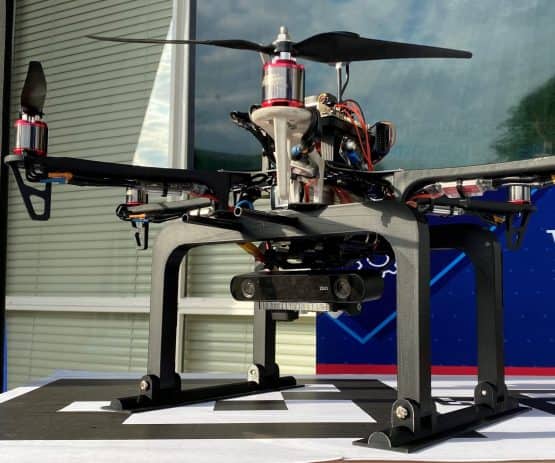
“It all started with a quad bike. Sieuwe Elferink is learning to drive one of these contraptions autonomously on the roads around his home. He does this with the help of end-to-end AI, a new technology where one model learns all the steps between the initial input phase and the eventual intended end result. This technology is based on human behavior. “So, you teach the model all the different parts at the same time, rather than sequentially. I was teaching the computer model how to steer, accelerate and brake. Then it occurred to me: do people actually do this with drones too?”
MultiMotorResearch
In a word, the answer is no. The main reason drones are hardly used for professional applications so far is because a human pilot is still always needed to control the drone. They are in short supply and therefore expensive and inflexible. This makes it an unattractive option for companies to use drones.
The young entrepreneur wants to change that. He now works for his own start-up, MultiMotorResearch, where he and other students from the Fontys University of Applied Sciences and the Eindhoven University of Technology (TU/e) are working on a fully autonomous drone for industrial applications. The drones can be used, for example, to inspect agricultural crops, secure sites or for autonomous deliveries.

Three modules in one
MultiRotorResearch’s system combines all the traditional modules that a drone uses to fly (the so-called perception, path planning– and control modules) into one.
Let’s say that there is a tall tree in a meadow. In traditional systems, the perception module detects the tree on the basis of camera images. The path planning module then plans a route around that tall tree, and the control module makes sure that the drone actually follows that route. Elferink: “Our system learns straight away which controls belong to a particular camera image based on human flight behavior. We teach the computer to fly like a human being flies.”
Flexible system
The goal is to develop the most flexible system possible. The model that controls the drone is trained properly in one go in every conceivable situation, e.g., high winds, tall trees, low bridges. Then it will be able to fly anywhere in the world.
“We teach the computer to fly like a human being flies..”
Sieuwe Elferink
He cannot guarantee that it will be a foolproof autonomous system. This is the long-tail problem of autonomy: 99 percent of situations are easy, 1 percent of them aren’t. “That’s where systems get stuck. And this is precisely the strength of our system over traditional systems. We teach the drones human adaptability, so that even those 1 percent of difficult situations are not an issue.”
Make lots of flight hours
MultiRotorResearch has now officially been in existence for six months, but the team has been working on the system for a year. The drone has logged a lot of flight hours. “Recently we had the AI system fly a flight and also flew that same flight manually. We came to the conclusion that ours makes almost the same choices as humans. That’s pretty cool.”
Agricultural analysis
The start-up recently received €40,000 in funding that will enable them to further develop the system in their collaboration with interested companies, including a drone manufacturer and an agricultural analysis company.
“We are focusing on agriculture first. There is a large group of farmers who are open to testing this type of system. The drone takes measurements of fields to help farmers improve their efficiency levels. For example, it is capable of measuring how much water is in the soil. This allows you to spray water in a much more targeted way. From there, we also want to put our efforts into security and energy checks.”
Theory and practice: a good product
The start-up’s team is made up of students from the TU/e and Fontys. Elferink himself is also a former Fontys student. The mix of the two works well. “TU/e students are theoretically strong, and people from Fontys are far more practical. That’s how you get a good product.”
“Finding good people is difficult, Elferink notes. The start-up cannot offer its team members any money. “So we have to rely on students who enjoy being on a team and find it interesting to grow along with the company.”

At least for now, that challenge doesn’t seem to be holding the young company back. Last summer it won the TU/e Contest in the ‘best prototype’ category. In two years’ time, the system should be ready for the market. “Then an investment round will be held, after which we will have another year to finalize the system, while we conduct tests with customers. I’m really looking forward to that.”

